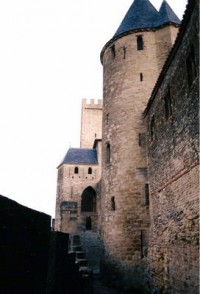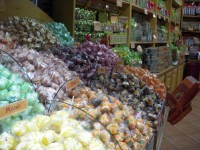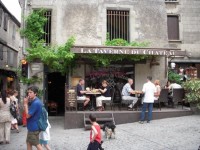I enjoy revisiting places I went to in France during my younger years now that I am an adult. It has reinforced for me the notion that age brings, if not wisdom, at least a different perspective and appreciation for history and culture. I remember visiting the medieval walled village of Carcassonne when I was nineteen and marveling over  these buildings and walls that were older than any structure I had ever seen. However, when asked about the history of Carcassonne upon returning from my trip, I was unable to even begin to explain it. To reconcile for the shortcomings of my youth- perhaps inattentiveness being the largest of them- I returned to Carcassonne this summer. I am pleased to say that I was as impressed as I was the first time I saw it, but this time I was thankfully able to absorb and retain more of it’s fascinating history.
these buildings and walls that were older than any structure I had ever seen. However, when asked about the history of Carcassonne upon returning from my trip, I was unable to even begin to explain it. To reconcile for the shortcomings of my youth- perhaps inattentiveness being the largest of them- I returned to Carcassonne this summer. I am pleased to say that I was as impressed as I was the first time I saw it, but this time I was thankfully able to absorb and retain more of it’s fascinating history.
 Located in Southwest France, Carcasonne was strategically built by the Romans during the 5th century to overlook the main thoroughfare between Toulouse and the Mediterranean Sea. Today, visitors can still see the main part of the lower courses of the northern ramparts that date from Gallo-Roman times. From the 5th to the 11th centuries, Carcassonne changed hands many times. In 462, the Romans officially ceded Carcassonne to the Visigothic king Theodoric II. Shortly thereafter, in 508, the Visigoths successfully thwarted attacks by the Frankish king Clovis. Saracens (from Barcelona) stormed Carcassonne in 725, but King Pippin the Younger drove them away in 759. Although Pippin was able to conquer most of southern France, he was unable to enter the impressive fortress of Carcassonne.
Located in Southwest France, Carcasonne was strategically built by the Romans during the 5th century to overlook the main thoroughfare between Toulouse and the Mediterranean Sea. Today, visitors can still see the main part of the lower courses of the northern ramparts that date from Gallo-Roman times. From the 5th to the 11th centuries, Carcassonne changed hands many times. In 462, the Romans officially ceded Carcassonne to the Visigothic king Theodoric II. Shortly thereafter, in 508, the Visigoths successfully thwarted attacks by the Frankish king Clovis. Saracens (from Barcelona) stormed Carcassonne in 725, but King Pippin the Younger drove them away in 759. Although Pippin was able to conquer most of southern France, he was unable to enter the impressive fortress of Carcassonne.
In the early 11th century, Carcassonne became a medieval fiefdom and was the property of Raimond Bernard Trencavel, viscount of Albi and Nîmes. The Trencavel family built both the Château Comtal and the Basilica of Saint-Nazaire, two of Carcassonne’s main tourist attractions. The city was conquered by northern French forces in the early thirteenth century. During the late seventeenth and early eighteenth centuries, as was the case with most monuments of the Middle Ages, the Walled City of Carcassonne was abandoned.
 The fortified walls of the Walled City of Carcassonne contain vestiges from all of these historical periods. Carcassonne is surrounded by its medieval double enclosure wall – the inner wall measures 1245 meters in length, with 29 towers, while the outer has 18 towers and is 1320 meters long. Though many of the original structures remain, parts of the walls and the city were restored in the mid-nineteenth century by the French architect, Eugène Viollet-le-Duc, who is considered to be one of the founders of the modern practice of historic conservation. Carcassonne became a UNESCO heritage site in 1997.
The fortified walls of the Walled City of Carcassonne contain vestiges from all of these historical periods. Carcassonne is surrounded by its medieval double enclosure wall – the inner wall measures 1245 meters in length, with 29 towers, while the outer has 18 towers and is 1320 meters long. Though many of the original structures remain, parts of the walls and the city were restored in the mid-nineteenth century by the French architect, Eugène Viollet-le-Duc, who is considered to be one of the founders of the modern practice of historic conservation. Carcassonne became a UNESCO heritage site in 1997.
 In addition to its fascinating history (of which I have just scratched the surface here), Carcassonne boasts an eclectic selection of candy, artisanal and souvenir shops, cafés and restaurants. Bars and eateries in the walled city stay open until around midnight, providing for a lively nighttime ambiance. After an enjoyable dinner at La Taverne du Château, we wandered around the walled city for a bit before making our way back down the hill to our hotel that was located in the newer part of the Carcassonne. As I made my way down the uneven medieval steps and turned to glance back up at Carcassonne, I felt the same appreciation and wonder that had struck me at age 19.
In addition to its fascinating history (of which I have just scratched the surface here), Carcassonne boasts an eclectic selection of candy, artisanal and souvenir shops, cafés and restaurants. Bars and eateries in the walled city stay open until around midnight, providing for a lively nighttime ambiance. After an enjoyable dinner at La Taverne du Château, we wandered around the walled city for a bit before making our way back down the hill to our hotel that was located in the newer part of the Carcassonne. As I made my way down the uneven medieval steps and turned to glance back up at Carcassonne, I felt the same appreciation and wonder that had struck me at age 19.
La Taverne du Chateau
2, Rue Cros Mayrevieille
11000 Carcassonne, France
Tel:33 4 68 25 95 35


Comments